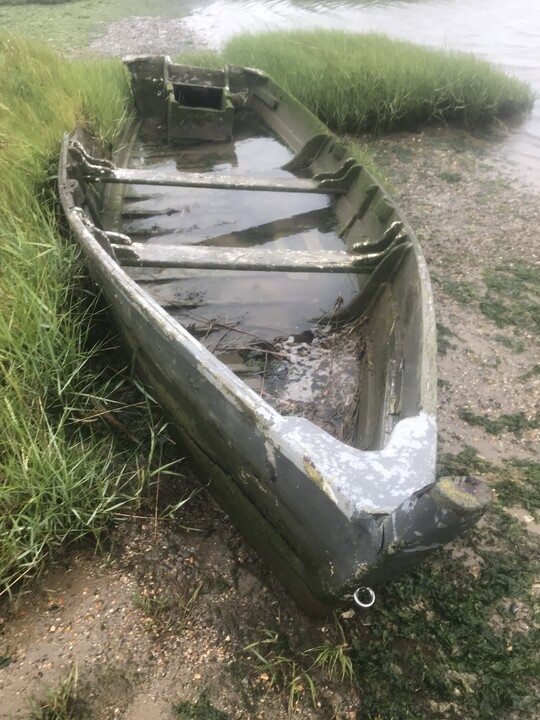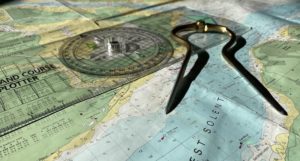In my last article, I introduced the compass as an amazing instrument that many of us use as part of our jobs at sea, in the air and on land… and most of us use to a greater or lesser extent, as a metaphorical tool in our personal and business lives.
I made the point that much of the language of navigation which is about finding a way through a territory, (which is either ‘known’ or ‘unknown’ with progress based on an ongoing series of systemic decisions), has found its way directly into the language of business and organisation. This is particularly true of discussions around leadership and change. The challenge therefore is to make sure the understanding of navigation, goes with… the language. There is much evidence that sadly it doesn’t, and this is causing problems and missed opportunities for enterprises.
There are 2 main sources of error waiting to ‘bite’ the unaware and the unprepared… Variation and Deviation. This is then amplified, by unpracticed, unqualified and unskilled application.
This article will consider therefore the practical application of dealing with Variation in a positive manner.
Variation in the field describes the difference between True and Magnetic North. True and Magnetic North are not interchangeable terms. In organisational life, Variation occurs between constructed maps and peoples take on ‘how it really is’. More particularly it also exists around the multitude of different compasses (decision making constructs) that exist in any group of people.
In organisational terms the challenge is to translate how things are represented in various enterprise charts, process or relational maps, into real world and real time questions… which are ‘where are we’ and ‘how are things going’.
These two questions can ‘present’ as simple to comprehend and simple to answer, with one being ‘static’ and the other describing ‘movement’. However both, are sophisticated and complex, as John Kay and Mervyn King describe in their recent book ‘Radical Uncertainty’. And of course, ‘reality’ will depend on who you talk to and what you measure… so… complicated!
At sea if I was asked ‘where are we?’, as the Captain I could answer this in many ways. Location on the earths surface, location in relation to weather fronts, location in relation to other vessels, location in relation to intended destination, height above the sea bed, direction and size of waves and general state of the sea, speed, speed over ground, depth, heading, bearing, fuel levels and fuel usage, crews competency, the buzz on the ship…. and I could go on… but all of this is wrapped together to represent a comprehensive and systemic answer. When I was a senior leader in one of the worlds great computer corporates, the question ‘Where are we’ and ‘how is it going’ could also be answered in many many ways… So it is not a simple question… and by the way… ask me again in an hour and my answer will be different! And at the heart of all of this is the compass.
Probably the biggest challenge however is just in the recognition that so many different compasses will be trying to get a ‘fix’ on this reality. The company may well have its own set of decision-making constructs expressed as a company wide protocol. Then every individual will also have their own ‘internal’ compasses that come into play. This represents a massive potential variation in its own right… At least in the field there is basically only one compass design!
With so many versions being deployed, we can end up in a tangle of decision-making priorities. This is what this article explores and offers a way through.
So which way is North?
Many of us have developed our own internal compass (or compasses) to guide our choices and decisions. The range and descriptions, vary enormously. These include a ‘Moral’ compass, a compass of ‘Emotional Intelligence’, a compass of ‘Empathy’ and a ‘compass of ‘4 intelligences’, defining Spiritual, Business, Political and Emotional Intelligence. Some writers have identified specific leadership traits and characteristics, (Servant Leadership, Fierce Determination coupled with Humility, Sustainability and anything that looks like Attila the Hun!), which underpin (in their view), successful leadership compasses for these times… and the list could on!
From an individual perspective all these expressions have validity.
The problem starts when people are brought together and collectively start trying to define ‘North’, to guide organisational decision making.
So, in terms of Variation, the big issue in the organisational context is about the difference between multiple decision making ‘compasses’ that measure all manner of things. North remains unclear and or… not agreed and clarity and agreement are not the same thing.
This range may be useful individually but is not helpful when trying to shift effort through the stages of adversarial, independent, cooperative, collaborative, and concordant behaviour. And the evidence is (Casey and Critchley and King and Kay) that you probably won’t sort complex morphing and demanding issues with just ‘cooperative’ behaviour. Effort needs at least to be collaborative, if not concordant.
If there is little agreement on the nature of the compass that will provide directional fixes and options, then working in a complex systemic space, which will also be continually shifting and morphing… will be a challenge (or an adventure) depending on your inclination.
So, what are the practical options?
What is being required in these unfamiliar and uncharted times, is a review of how we make and take decisions. Effectively this is about aligning our compasses and agreeing the key ‘cardinal points’ and particularly ‘Magnetic’ North as opposed to ‘True’ North which is largely a notional place described by mathematics and geometry. This includes gaining clarity and agreement on how choices are processed and agreed. I would assert that this needs to be inclusive and have both depth and breadth so that choices are informed by….
- The unique context and culture in which we are navigating. Sounds simple but is much more complex in reality and will require perhaps the development of new models and understanding rather than rehashing the old
- The complexity of the issue. Puzzles and problems require different approaches… and the challenge is that we have been educated and then further trained, in finding the ‘one solution’. This is the fundamental premise of puzzle solving. However, life isn’t that simple! Again, King and Kay in their recent book ‘Critical Uncertainty’ have much to say on this. Just the chapter on ‘Probability’ in all its forms (and often wrong assumptions and usage) … should challenge all of us, to review our own understanding of this key area
- The rules and regulations that govern and guide decisions. These both exist in various regulatory frameworks and are assumed. Just an exploration of the ‘permissions’ we give ourselves is a rich and potentially transformational study
- An understanding of sequencing and prioritisation with the skill of being able to ‘read, interpret and extrapolate’, being a foundational competency. At sea this took me years to master and a continuing lifetime to truly understand!
- Specific and clear Inhouse decision making protocols. This is like the one agreed, default, ships compass
- Escalation processes and routes, for all the ‘unknown unknown’ events that make up much of our operating context. There is a debate about the importance of defining ‘routes and road maps’ over just remaining ‘adaptable to change’. Many still prefer the ‘road map and programme approach’. This works Ok when there is little unknown, thanks to great digital analysis and scenario panning which in turn gives a fair degree of control over decisions. The issue in these days of massive turbulence, is when you have limited information, (if any at all) and are not in control of things. ‘Road maps’ become an amusing irrelevance. Here adaptability to circumstance is the key, with courage and creativity coming to the fore
- The robustness of the relationships. Simply put, it is difficult (and I would say almost impossible) to work and solve complex, morphing, and systemic issues if the relationships of the key stakeholders are underdeveloped and immature. This is where an intelligent application of EQ principles is helpful
- The maturity of and integration of appropriate DIGITAL approaches, tools, and instrumentation. We all talk about the 3 legged stool of Digital, Process and People. Very few actually practice it, as the latest figures of DX transformational success would indicate
- A comprehensive understanding of the Economics going on, related to our risk models and assumptions
If all the above are made clear, explicit and the implications are agreed, this for me would tackle the main issue of Variation as experienced in organisational settings. The results also need to be published so that there is shared visibility and accountability.
Now many leaders seeing the above would say ‘in the real world we don’t have the luxury of time to do all of this’.
And in the Mariners world, failure to work issues of Variation, end up as ‘disasters at sea’ described by the inevitable enquiry and report, that will allocate responsibility, blame and accountability in the most public of ways. And we must remember that most change programmes still fail to deliver success. The IBM and Change-Ability quantitative research that ran for over a decade each, is sobering. The rate of catastrophic Digital Transformation failure continues to be simply staggering despite a world-wide annual Change Management expenditure of some $10 Billion…. because leaders and their teams say they ‘don’t have the time and resources’ to do things… even that, which is required at a basic level. I explore this in my book. Navigating Change. A Leaders Guide. Published in 2019
Two Questions.
- When you meet and work as a team, planning for and implementing change, how much time do you give to consider and align the various ‘compasses’ that exist in the team?
- How clear and agreed is your decision making process between all stakeholders?
- What do you have you in place when you find yourself off chart and your compasses are are all pointing different ways?
The last post Article 3, published next week, explores how our compasses (and how we see things), inevitably become contaminated. I will explore how we might develop the habit of checking the degree of error each one of us (and every field compass) carries and how to compensate for this.
Links to the series of articles:
- Navigating Unfamiliar and Uncharted Waters: Make better use of the Compass with all its error and bias.
- The Compass in context and its role in navigation
- Dealing with Variation and the practical application
- Dealing with Deviation and practical application.



